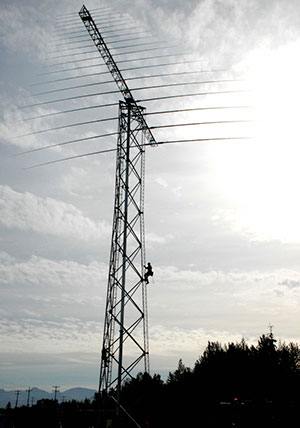
Proven technology remains viable disaster communication toolBy JOHN BUDNIK
October 27, 2014
High-frequency radio has withstood the historical evolution of telecommunications and remains a relevant means to transmit information over long distances. The mode is used by emergency management organizations and amateur enthusiasts, also known as ham operators. Therefore, the U.S. Army Corps of Engineers – Alaska District upgraded its capabilities in July with a new antenna. “Technology is always changing,” said Ed Luteran, quality management assistant and high-frequency communications specialist for the Alaska District. “You want to make sure you can match other stakeholders so contact can remain during a disaster.” The district installed a 102-foot-tall radio tower to support the Emergency Management Office. While replacing an older 30-foot-tall structure, the new apparatus is equipped with two aviation lights and a motor for rotating the 72-foot-long boom of a 2,100 pound directional antenna. “This upgrade will help the Alaska District remain operable during a crisis and to communicate with our headquarters and other responding agencies when normal means of contact have failed,” said David Spence, chief of the Emergency Management Office. The Alaska District assists the Federal Emergency Management Agency in responding to a full range of major disasters. In particular, the district provides public works and engineering recovery support as constituted by FEMA’s national defense framework. Also known as shortwave radio, high-frequency waves travel at the speed of light. These waves reflect off the ionosphere in the atmosphere and back down to earth. Transmissions can be received globally. “You have the ability to communicate with minimal infrastructure,” Luteran said, who is a licensed Federal Communications Commission ham operator and volunteer for the Military Auxiliary Radio System in Alaska. Extra equipment is necessary to relay other forms of telecommunication signals between the people transmitting messages. One example is the Alaska Land Mobile Radio system, which relies on a series of signal-repeating towers located alongside the state’s highways. This method promotes interoperability between federal, state and municipal partners. Public safety officials are able to link with other agencies and entities across the state, including with the Alaska District, using handheld radios during a crisis. However, if an earthquake destroys one of those towers, the viability of the system is compromised. Internet, satellite phones and everyday cell devices also rely on similar supporting infrastructure in order to perform. Standard handheld radios transmit on a bandwidth only useful for line-of-sight distance. Though shortwave radio is dependent upon minimal equipment, it serves well as a backup to technology that is easier to use and requires less expertise. Typically, the operator needs to understand the necessary circumstances in the ionosphere to make successful transmissions. Solar activity, frequency and seasonal changes can affect the broadcast conditions. “You can generally forecast by knowing what has occurred from the sun, but that is just one of many factors,” Luteran said. “It’s important for the operator to know radio theory of operations.” Whether an emergency management organization is practicing for a major event or dealing with a real crisis, communication can be the highest sought after commodity when in dire straits. “The sharing of information is always a challenge,” Spence said. “It’s important to be in contact with your emergency partners to effectively stage a recovery effort.” During the next geological, weather-related or man-made disaster, a proven and reliable technology is ready to help the Alaska District achieve emergency notification.
|
|||
